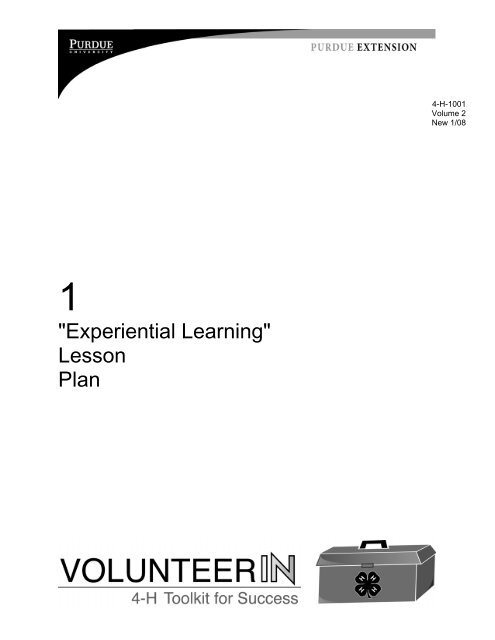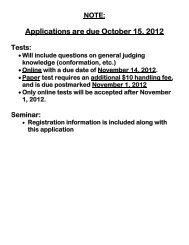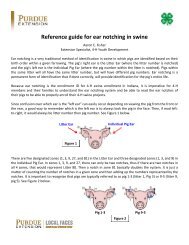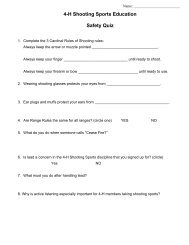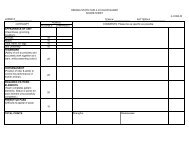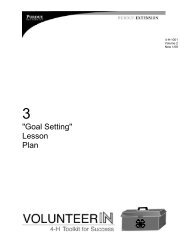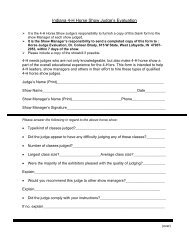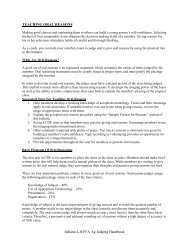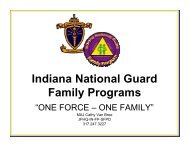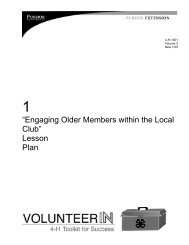"Experiential Learning" Lesson Plan - Indiana 4-H - Purdue University
"Experiential Learning" Lesson Plan - Indiana 4-H - Purdue University
"Experiential Learning" Lesson Plan - Indiana 4-H - Purdue University
- No tags were found...
You also want an ePaper? Increase the reach of your titles
YUMPU automatically turns print PDFs into web optimized ePapers that Google loves.
1"<strong>Experiential</strong> Learning"<strong>Lesson</strong><strong>Plan</strong>4-H-1001Volume 2New 1/08
2Learning Objectives1. Recognize the five steps of the <strong>Experiential</strong> Learning Model.2. Experience the model.3. Describe how <strong>Experiential</strong> Learning applies to positive youth development.Supplies & Resources Needed<strong>Lesson</strong> plan with instructional objectivesNotes pages of PowerPoint presentation with talking pointsLCD projector and laptop with PowerPoint presentation loadedCopies of PowerPoint slides printed as a three-slides/page handout for each participantCopies of lesson plan quiz for each participantPencils or pens for volunteers to take notes and complete the quizCopies of “<strong>Experiential</strong> Learning” fact sheetStraws and coffee stirrers for the activityReferencesDiem, K. G. (2001) Learn by Doing the 4-H Way. New Brunswick, NJ. Rutgers Cooperative Extension.Koch, K. (2006) <strong>Experiential</strong> Learning Model slide show. Noblesville, IN. <strong>Purdue</strong> Cooperative Extension.Projected Length20-25 minutesInstructor Notes If you will be using the PowerPoint presentation to share this lesson with the volunteers, set up the laptop andLCD projector prior to the start of the program and test the equipment to be sure it is working properly. Welcome the group and thank them for their participation. Begin the “<strong>Experiential</strong> Learning” PowerPoint presentation. Utilize the talking points found on the notes pages of the PowerPoint presentation to guide you during thepresentation. Review the purpose and objectives for this lesson plan. Provide a brief introduction of the lesson, including its importance to the 4-H Youth Development Program. Proceed with the lecture portion of the lesson. Distribute the "<strong>Experiential</strong> Learning” fact sheet to each participant. Conclude the lesson with a time for questions from the participants.
3Methods/ContentInformation found on Slides #1-2.IntroductionAs part of the Mastery Concept of the Essential Elements of 4-H, <strong>Experiential</strong> Learning is the educational basis for all 4-Hprojects.When youth “learn by doing” they experiment, use trial and error, analyze what’s happening, and draw conclusions. Theylearn lessons through experience.This lesson is designed to help you learn about the steps of the <strong>Experiential</strong> Learning Model and help you, as volunteers, leadyouth in discussions that will help them learn lessons and benefit from the model.The three objectives of this lesson are:1. Recognize the five steps of the <strong>Experiential</strong> Learning Model.2. Experience the model.3. Describe how <strong>Experiential</strong> Learning applies to positive youth development.Objective 1Recognize the five steps of the <strong>Experiential</strong> Learning Model.Information found on Slide #3.Often referred to as “Learning by Doing”Learner experiences a problem or activity and makes sense of the solution on his or her own (withminimal assistance from the adult helper)Model is divided into five steps, and summarized into three main processesIn this model, the learner has the experience with minimal assistance from the adult helper.So what exactly is the <strong>Experiential</strong> Learning Model? Quite often we experience some form of this learning when we areconfronted with doing something new or different, whether we realize it or not.
4Information found on Slide #4.The <strong>Experiential</strong> Learning Model includes five steps: Experience, Share, Process, Generalize, and Apply. Let’s take a lookat each of these steps in more detail.Information found on Slide #5.Experience Engage in an activity that:o Is likely unfamiliar to the participanto Is possibly uncomfortable, pushes personal limitso Offers minimal instruction- let the participants figure something out before being told how to do itThe first step of the <strong>Experiential</strong> Learning Model is “Experience.” The learner must engage in an activity to learn from it.Quite often the learner has never done this activity, or is doing it in a new or different way. An example of this might bemaking a repair or solving a problem you have never encountered, trying a new recipe, or creating a project out of materialswith which you have never worked. Instead of giving the learner a step-by-step plan, the adult helper allows the person to trydifferent methods to reach the desired results.Information found on Slide #6.Share (What happened?) Participants should talk about what they experienced while doing the activity.o Reactionso Observationso Feelings Encourage discussion and expression of ideas and feelings.o The leader should have some questions ready to aid the discussion or should bring up majorpoints.At the “Share” step, the discussion should focus on what happened with the activity at hand. Questions that you might askinclude, “How did you do what you did? Did you achieve the desired result? What happened?” At this step, it is importantfor the youth to express their experience in doing the activity. If the group is not willing to share their experiences, it will behelpful for the leader to have some questions on hand that will prompt the youth to share.
5Information found on Slide #7.Process (What's important?) Analyze and reflect on what happened. Discuss how problems and issues were brought out through the experience. Discuss how these problems and issues were addressed. Discuss personal experiences of participants. Look for recurring themes.To process our experience, we try to find what was important in what happened. At this point, we reflect on what happened,why it happened, and if the end result was the desired result. We begin to put some pieces together. Is there a relationshipbetween what was done and what happened? Were our actions modified throughout the experience so we could achieve thedesired result? How were issues or problems addressed? At this point we might ask participants to share their experiences incarrying out the activity and tell the rest of the group about their successes and failures. For some activities, we might ask ifthe participants would have learned as much by reading or hearing about something as opposed to actually experiencing it.Information found on Slide #8.Generalize (So what?) Find trends or common truths in the experience. Relate the experience to "real life." Identify key items that were learned. Identify key terms to relate to the experience.The next step is to generalize the experience. Find common themes or trends in the execution of the activity. Did a certainrepeated behavior affect the outcome of the activity? Was this positive or negative, and how should it be applied in thefuture? Also relate the experience to the members’ lives and related experiences youth might encounter in an uncontrolledenvironment. This is also the time to discuss the major lessons from the experience, and identify terms to relate to theexperience.Information found on Slide #9.Apply (Now what?)How can lessons be applied elsewhere?How will the lessons learned be useful in the future?Discuss how behaviors and actions can be modified to improve the results, or how results can beaccomplished more efficiently.
6To apply the <strong>Experiential</strong> Learning Model, we take the lessons learned today and use them in our lives as we encounter newexperiences. As leaders, you can discuss how this technique can be used, and probably is used, every time someone goesthrough a new and different experience. One major point to make with young people is how their behavior might be affectedby this new learning process. Will they be as careless/too careful next time they try a similar activity? Does frustration solveany problems? What thought processes go through one’s mind as he or she tries something new?Information found on Slide #10.Key Points to RememberAsk open-ended questionsEncourage open and non-threatening discussionMistakes are fine - that’s how we learn!As you work with members using the <strong>Experiential</strong> Learning Model, you’ll want to remember these key points: Ask open-ended questions that encourage members to think…not just about the activity they experienced, but alsoabout the skills they have learned that they can use elsewhere in their lives. Encourage discussion among the members – this is a safe environment in which we can try new things. Members are not expected to know how to do the activity by themselves; mistakes will happen and that’s O.K.!Objective 2Experience the model for ourselves.Information found on Slides #11-12.Let’s try it!Smoking or disease can affect lung capacity and breathing.o Breathe through a straw.o Breathe through a coffee stirrer.Compare the difference.Now, do this while doing ten jumping jacks.Over time, smoking cigarettes can limit lung capacity and will prohibit a smoker from taking full breaths. Eventually, manysmokers develop an irreversible condition called emphysema, which severely limits lung capacity and function. Many peoplehyperventilate just to take in enough oxygen through simple activities such as climbing stairs or walking too fast. Unless youhave smoked for years or suffer from emphysema, it is hard to understand how difficult breathing can become. This activitylimits our oxygen intake and simulates what it is like to breathe under those conditions.
7The model at workExperienceShareProcessGeneralizeApplyShare: What happened to your ability to breathe? Were you able to take in as much oxygen as you needed?Process: What was the worst part about this activity? What could happen if you were forced to breathe like this? Would yoube able to do all of the things you currently do? Would you have to alter some of your activities?Generalize: Is life more difficult for people who smoke or suffer from lung disease? Has there been a time when you had acondition that limited your participation in your favorite activities? How would you describe this experience?Apply: Can this activity be applied to your life? Will you modify any behaviors as a result of this activity?Objective 3Describe how <strong>Experiential</strong> Learning applies to positive youth development.Information found on Slides #13-14.How does this (<strong>Experiential</strong> Learning Model) apply?Youth develop life skills.o Learning skillso Decision makingo Positive Self-Concepto Communicating and relating to otherso Responding to needs of othersInstead of being told how to do something, youth are able to experience it for themselves first hand when we use the<strong>Experiential</strong> Learning Model. By participating in the activity, they are learning something new. By using trial and error orexperimentation, youth will develop their decision-making skills. This is a time when they must decide if a behavior needs tobe altered to achieve the desired results, or how something might be modified to get better results. By making their owndecisions and seeing them followed through, this model will help youth develop a positive self-concept. They will see theiridea carried through. By using multiple senses, youth are more likely to retain the lessons that are learned.
8How can you use the <strong>Experiential</strong> Learning Model?Develop programs that challenge participants through new experiences.Educate volunteers and parents.Be creative and have fun!As an adult volunteer, you can use the <strong>Experiential</strong> Learning Model in many ways. 4-H projects are based on this “learningby doing” model. Leaders should encourage youth to try new things, which will expand their experience level and assist themin developing the life skills previously mentioned. It could also be your role to assist parents and other volunteers to use the<strong>Experiential</strong> Learning Model when working with youth. By giving them the basic information about this model, adults will beable to guide youth to learn by experience, rather than from the adult’s perspective.Conclusion and QuizWhat questions do you have about the <strong>Experiential</strong> Learning Model?Information found on Slides #15-16.Review the lesson and allow time for any questions from the volunteers related to the lesson. Then distribute quizquestions. Allow volunteers time to answer the questions. Provide the correct answer from the key provided in thispacket. You may choose to collect the quizzes or allow the volunteers to keep them and use them as a review ofthe lesson.Thank the volunteers for their participation.It is the policy of the <strong>Purdue</strong> <strong>University</strong> Cooperative Extension Service that all persons have equal opportunity andaccess to its educational programs, services, activities, and facilities without regard to race, religion, color, sex,age, national origin or ancestry, marital status, parental status, sexual orientation, disability or status as a veteran.<strong>Purdue</strong> <strong>University</strong> is an Affirmative Action institution. This material may be available in alternative formats.
“<strong>Experiential</strong> Learning” Quiz91. Which of the following is not one of the five steps of the <strong>Experiential</strong> Learning Model?a. Shareb. Experiencec. Refuted. Processe. Apply2. Name two life skills that the <strong>Experiential</strong> Learning Model helps youth develop.3. True or False: The <strong>Experiential</strong> Learning Model leaves very little room for error whenyou attempt something for the first time.4. “____________ by ______________” is a phrase that can be used to describe the<strong>Experiential</strong> Learning Model.
10- KEY -“<strong>Experiential</strong> Learning” Quiz1. Which of the following is not one of the five steps of the <strong>Experiential</strong> Learning Model?c. Refute2. Name two life skills that the <strong>Experiential</strong> Learning Model helps youth develop.Some life skills that can be developed through the <strong>Experiential</strong> Learning Model include learning, decisionmaking, positive self-concept, communication, relating to others, and responding to needs of others.3. The <strong>Experiential</strong> Learning Model leaves very little room for error when you attempt something forthe first time.FALSE. The <strong>Experiential</strong> Learning Model encourages the learner to learn by doing. Mistakes areexpected and students will learn from these mistakes.4. “_Learning___ by __Doing____” is a phrase that can be used to describe the <strong>Experiential</strong>Learning Model.“Learning by Doing”


